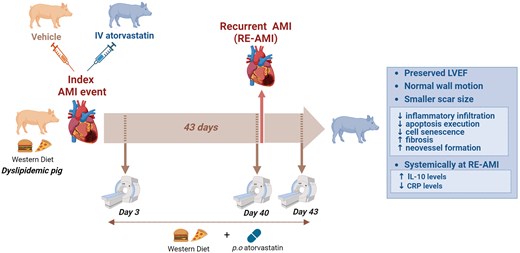-
Views
-
Cite
Cite
Gemma Vilahur, Soumaya Ben-Aicha, Manuel Gutiérrez, Monika Radike, Guiomar Mendieta, Lisaidy Ramos, Sebastia Alcover, Laura Casani, Gemma Arderiu, Teresa Padró, María Borrell-Pages, Lina Badimon, Cardioprotection exerted by intravenous statin at index myocardial infarction event attenuates cardiac damage upon recurrent infarction, Cardiovascular Research, Volume 121, Issue 2, January 2025, Pages 283–295, https://doi.org/10.1093/cvr/cvae264
Close - Share Icon Share
Abstract
Recurrent acute myocardial infarction (RE-AMI) is a frequent complication after STEMI, and its association with stent thrombosis can be life-threatening. Intravenous atorvastatin (IV-atorva) administration during AMI has been shown to limit infarct size and adverse cardiac remodelling. We determined by cardiac magnetic resonance (CMR) whether the cardioprotection exerted by IV-atorva at the index AMI event translates into a better prognosis upon RE-AMI in dyslipidemic pigs.
Hypercholesterolemic pigs underwent a first AMI (90-min coronary balloon occlusion). During ongoing ischaemia, animals received IV-atorva or vehicle. Forty days later, animals underwent RE-AMI and were sacrificed on Day 43. All animals remained on p.o. atorvastatin and a high-cholesterol diet from the first AMI until sacrifice. Serial CMR analysis was performed on Day 3 post-AMI, prior- (Day 40) and post-RE-AMI (Day 43). No differences were detected in oedema formation in both animal groups during AMI and RE-AMI. Gadolinium DE-CMR revealed smaller infarcts in IV-atorva-treated animals at index event at 3 and 40 days post-AMI compared to vehicle-administered pigs (P < 0.05). CMR analyses post-RE-AMI revealed smaller infarcts in the animals treated with IV-atorva at index event than in the vehicle-administered pigs. These IV-atorva at index event benefits were associated with higher left ventricular (LV) ejection fraction and normal LV wall motion in the jeopardized myocardium at RE-AMI (P < 0.05 vs. vehicle). The scar region of RE-AMI of animals treated with IV-atorva at index event showed reduced cardiac inflammatory infiltrate, apoptosis and senescence activation, and increased reparative fibrosis and neovessel formation vs. vehicle-administered pigs. Animals treated with IV-atorva at index event also showed lower C-reactive protein and higher interleukin-10 plasma levels in the setting of RE-AMI.
The cardioprotection afforded by IV-atorva administration during an index-AMI event shows a legacy effect attenuating myocardial damage and preserving cardiac contractile function upon RE-AMI. The potential benefits of this intravenous approach should be tested in the clinical setting.






